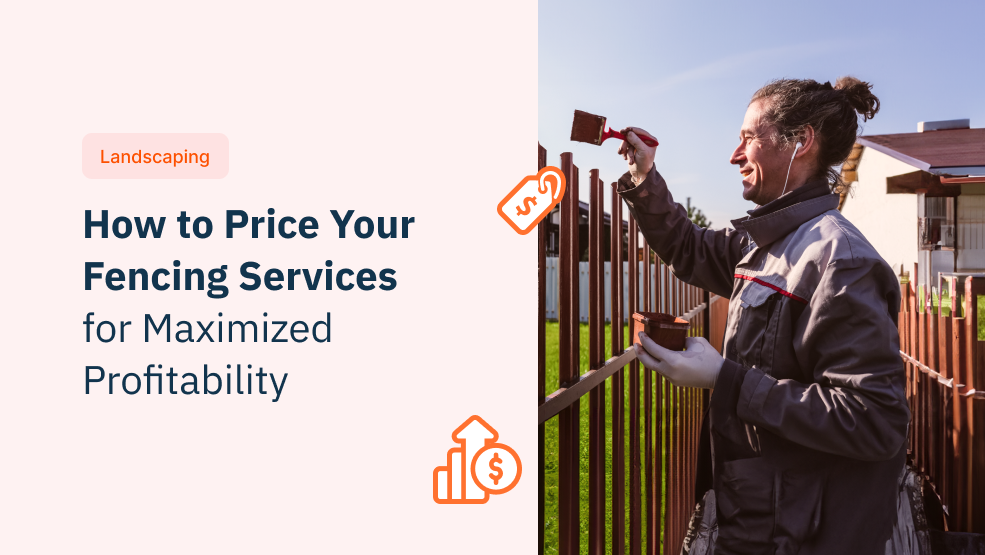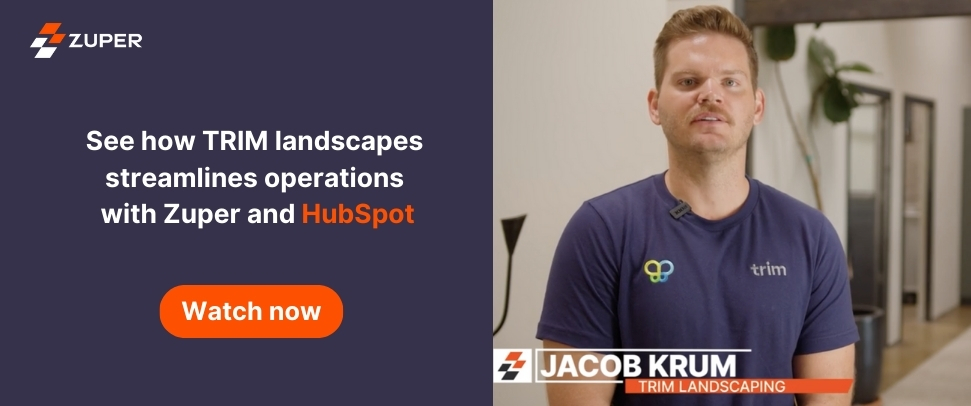Pricing a fencing job isn’t easy. There are many considerations, so how do we calculate costs accurately? What’s a fair price that covers expenses and turns a profit without scaring away clients? It’s frustrating when competitors undercut your pricing or clients try to negotiate. But it doesn’t have to be this way. In this article, you will learn how to assess project requirements thoroughly, understand your costs completely, and present a polished quote that makes clients say “yes!”
Understanding the key costs of a fencing project
To accurately price a fencing job, you need to understand the costs involved. The three major costs are materials, labor, and overhead. Materials refer to the physical components required for the project, like wood, vinyl, or metal posts and rails, as well as concrete, gravel and treated lumber for the posts. Make sure you factor in costs for special order items or premium materials if needed. You’ll also want to account for potential waste and extras in your estimate.
Labor costs depend on the complexity of the job as well as your experience and qualifications. Determine an hourly rate for yourself and any employees working on the project. Then estimate the total hours required based on the linear footage of fencing and any obstacles. It’s best to overestimate labor time to avoid going over budget.
Overhead costs include vehicle maintenance, fuel, marketing or promotional expenses, licensing or certification fees, and other administrative costs. You’ll want to determine an overhead rate, say 30-50% of direct costs, to build into your estimates. By understanding your costs inside out, you can determine prices that ensure profitability while remaining competitive. Meet with the client, assess the specifics of the project, and use your knowledge of costs to craft an estimate that works for both of you.
With the right tools and knowledge, pricing fencing jobs accurately becomes second nature. Developing a standardized process for calculating costs and determining prices will allow you to efficiently bid on new jobs while maintaining healthy profit margins. In the end, a fair price is one that covers your costs, values your services, and satisfies the customer.
Calculating material expenses
To accurately price a fencing job, you need to factor in the cost of materials. This includes everything from wood and vinyl panels to concrete, posts, nails, and any extras like gates or caps. The first step is to measure the perimeter of the area you need to fence. Divide this number by the size of the fencing panels you plan to use. This will tell you exactly how many panels you need to purchase.
Choose your materials
Determine what materials you’ll use based on your customer’s needs and budget. Higher-end options like redwood, cedar and ornamental steel will cost more than basic chain link or pine. Check current lumber prices to estimate wood costs. For vinyl, metal and other materials, get quotes from your suppliers.
Don’t forget the details
Posts, rails, pickets, nails, screws and other hardware can significantly add to your total material costs. You’ll also need concrete to secure the posts in the ground. If the customer wants a gate, stain/paint or caps, include those in your estimate as well. It’s best to overestimate rather than run short on materials during installation.
Double check your math
Take the time to double check all your calculations to avoid costly mistakes. Remeasure the perimeter and recheck the amount of materials needed. Confirm current prices with suppliers. Compare your total material estimate to similar jobs you’ve done to ensure accuracy. The last thing you want is to realize halfway through a job that you underestimated the materials, cutting into your profit margin.
By thoroughly assessing the specifics of each fencing job and carefully calculating material expenses, you can provide an accurate cost estimate and ensure a reasonable profit on each project. Precision and attention to detail are key to winning bids and building a successful fencing business. Understanding your true costs is the only way to price your services competitively and scale sustainably over the long run.
Estimating labor costs and pricing experience
When determining your labor costs, the most important factor to consider is your level of experience. As a fencing professional, your experience directly impacts how efficiently you and your crew can complete a job. With more experience comes faster work and higher quality results.
If the technicians are earning as per the below example,
| Years of Experience | Hourly Rate |
| 0-4 years experience | $20 per hour |
| 5-10 years experience | $25 per hour |
| 10+ years experience | $30 per hour |
Then, for per-foot installation pricing, examine the rates of competitors in your area, then adjust based on your experience and quality of work. An experienced crew can often demand 10-30% higher rates. However, don’t price yourself out of competitiveness. Find the ‘sweet spot’ that conveys your value while still appealing to most customers.
The complexity of each project also impacts your labor pricing. Installing a basic wooden privacy fence typically takes less time than a custom wrought-iron fence or a fence on hilly, rocky terrain. When assessing job sites, note any factors that could slow down your work or require special equipment/skills. Increase your labor rates and total bid for more complex projects to account for the additional effort required.
By accurately determining your costs and pricing experience and complexity into each bid, you can establish labor rates that are both profitable and competitive. Win more clients and grow your business through a reputation for high-quality, fairly-priced work. With time and practice, pricing each new fencing project will become second nature.
Incorporating overhead into your pricing
Overhead costs are essential business expenses not directly related to any particular project. Things like rent, utilities, insurance, marketing, and vehicle maintenance all fall under this category. While these costs aren’t tied to a specific job, they are necessary to keep your business running.
To determine your overhead rate, calculate your total overhead costs for the year and divide that number by your total revenue. For example, if your annual overhead costs are $50,000 and your total revenue is $200,000, your overhead rate would be 25% ($50,000 / $200,000 = 0.25).
Once you know your overhead rate, you can easily incorporate it into your job pricing. Simply add your direct costs (materials + labor) and multiply that total by your overhead rate. So if the direct costs for a job are $5,000 and your overhead rate is 25%, you would charge $6,250 for that job ($5,000 x 1.25 = $6,250). This ensures that you account for overhead costs and build in a profit.
Performing a thorough site assessment
To provide an accurate quote for a fencing job, a site assessment is crucial. You need to factor in every detail to calculate the total linear footage and materials required. Head out to the job site with your measuring tools—a measuring wheel, tape measure, or laser distance measurer. Starting at one end of where the fence will be installed, measure each straight section and record the lengths. For corners or around obstacles, you may need to measure in segments. Add up all the measurements to get the total linear footage.
Evaluating the terrain
Look at the layout of the land. Are there any slopes, uneven areas or obstacles like trees, bushes or structures that will impact your work? Note details about the terrain and any removals or additional labor needed. The terrain can significantly impact the difficulty and time required for a job.
Determining materials
Decide on the fencing material based on the client’s needs and your site assessment. Calculate the amount of each material needed, like posts, pickets, rails and hardware. Measure any gates required and account for extra materials in case of waste or damage.
Additional services
Discuss any additional services with the client, such as removing old fencing, clearing brush, or building retaining walls. Include the extra costs and labor hours for these services in your final quote.
Presenting the quote
Provide the client a written quote outlining the scope of work, materials, costs, timeline and payment schedule. Explain your pricing in a clear, professional manner. Be prepared to negotiate if needed, but stand firm on covering your costs and making a reasonable profit.
Conducting a thorough site assessment and quoting accurately is key to a successful fencing job. Take the time to evaluate all the details and factors to provide the client an honest, comprehensive quote for the work required. This will set the right expectations and allow you to complete the job profitably.
Creating a detailed project scope outline
Putting it in writing
After thoroughly assessing the job site and requirements, it’s critical to document the project scope in writing. This helps ensure you and your client are on the same page regarding expectations and inclusions before work begins. Your scope of work should outline details like:
- The total linear footage and height of fencing required
- The specific materials being used, like vinyl, wood or metal
- The number of gates needed and their dimensions
- Any existing structures that need to be removed or worked around
- The proposed timeline for completing the work
Additional Services
Be sure to specify any additional services you’re including, such as hauling away debris, clearing brush, or repairing damaged areas of existing fencing. Providing a comprehensive scope of work helps avoid confusion, change orders, and disputes down the road. It also allows you to give an accurate price for the job based on the details outlined.
Change orders
Of course, unforeseen issues can arise once work begins that require modifications to the original scope. Be prepared to issue change orders if additional materials, labor, or services become necessary. Explain the changes to your client, provide a revised price, and have them approve the new scope in writing before proceeding.
Staying on track
With a detailed scope of work in place, you have a roadmap to keep the project running smoothly from start to finish. Refer to the document regularly and check that work is progressing as outlined. Make adjustments as needed in a transparent manner by revising the scope and obtaining client approval. A well-defined scope of work is key to accurate pricing, managing expectations, and delivering a high-quality end result.
Cost-plus pricing method
With cost-plus pricing, you calculate the total cost required for a fencing job and add a predetermined profit margin to determine your price. To use this method, follow the formula:
| Material Cost + Labor Cost + Overhead Cost = Total Cost
Total Cost x Profit Margin = Price |
For example, if a vinyl fence installation will require $2,000 in materials, $1,500 in labor (for 2 installers over 3 days), and your overhead costs are $500 (including transportation and equipment costs), your total cost is $4,000. If your target profit margin is 25%, you would charge $5,000 for the job ($4,000 x 1.25 = $5,000).
This method is straightforward but may result in a price that’s too high for your market or customers. You’ll need to consider competitor rates and what potential clients will be willing to pay. You can then adjust your profit margin accordingly. For example, you may start with a 25% margin but drop it to 20% to match competitors while still making a solid profit.
The key is finding the right balance through experience. As you complete more jobs, you’ll get better at accurately estimating costs and setting competitive yet profitable prices. You may be able to increase your margins over time as you build your reputation and demand for your services grows.
Some tips for using the cost-plus pricing method:
Track your actual costs
Make sure you understand your true costs for materials, labor, equipment, and overhead. This will allow you to set an appropriate profit margin.
Factor in complexity
For more complex jobs that require specialized equipment or skills, you may need to increase your profit margin to account for the added effort and risk.
Consider the customer
For high-end residential clients, a higher profit margin may be suitable. For budget-conscious customers, you may need to accept a lower margin to win the job.
Review and revise
As you gain experience, review the profit margins and prices on past jobs. Look for patterns to help refine your cost estimates and pricing for future projects. Make revisions as needed to improve your profitability.
The cost-plus pricing method, when done right, can help ensure you consistently price jobs profitably and competitively. Pay close attention to your actual costs and be willing to adjust as needed to find the sweet spot for your business and customers.
Competitive pricing
As a fencing contractor, you need to stay on top of what your competitors are charging for similar services. Competitive pricing means analyzing the going rates in your area and adjusting your prices accordingly based on your experience, quality of materials, and any unique offerings you provide.
Checking your competitors’ pricing is a key part of developing an effective bidding strategy. Visit their websites, get estimates for similar projects, and see what they advertise as their rates per linear foot for materials and installation. While you don’t want to price yourself out of the market, you also don’t want to sell yourself short.
Factor in your years of experience, certifications, quality of materials used, and any warranties or guarantees you provide. If you’ve been in business for over 10 years, use high-end vinyl or aluminum materials, and offer a lifetime warranty on parts and labor, you can likely charge on the higher end of the range. Make sure any price premiums you charge are clearly outlined in your quotes and marketing materials.
You should also consider your business costs and desired profit margins when setting your rates. Don’t just match the lowest price in town if it means barely breaking even on jobs. Find the sweet spot that allows you to be competitive, cover all your costs, and still make a reasonable profit.
When presenting your quote to a customer, be very transparent about what is included for the price. Break down material and labor costs, provide specs for the materials you plan to use, and outline any additional services or benefits. This level of detail demonstrates the value you provide and helps to justify your pricing, especially if it’s on the higher end of the range.
Staying up to date with competitor pricing and being able to articulate your value proposition are key to effective competitive pricing. Adjust as needed to match market rates, but don’t be afraid to charge a premium for the experience, quality, and service you provide.
Value-based pricing
Once you’ve calculated your material, labor and overhead costs, it’s time to determine your pricing. Value-based pricing focuses on the benefits and value you provide to customers rather than simply factoring in your costs.
With value-based pricing, you determine a price that properly reflects the worth of your services to clients. Consider what makes your business unique and the key features that set you apart. For example, do you offer premium materials, specialized installation techniques or a lifetime warranty? Emphasize these in your quote to demonstrate the added value.
When meeting with clients, focus the conversation on the advantages of hiring your company. Explain how your experience, skills and high-quality work will benefit them in both the short and long term. Discuss how proper fencing can increase home value, enhance curb appeal and provide security. Frame your services as an investment that will pay off over time.
You should also consider your target customers and what they can afford. While you never want to charge less than your costs, you need to remain competitive. Research the going rates of comparable fencing companies in your area. Price at or slightly above the average, emphasizing why your services warrant a premium.
Be transparent in your quote by providing a detailed scope of work, timeline and list of inclusions. Explain each cost clearly and tie it back to the value provided. Offer different packages at varying price points so customers can choose what best suits their needs and budget. Provide financing or payment options to make the investment more accessible.
When you focus on value over costs, you open up opportunities for greater profit margins. Value-based pricing allows you to build a reputation for high-quality work and establish long-term customer relationships. It creates a win-win by giving clients a fair price for an exceptional fence and ensuring your business remains sustainable and thriving.
Presenting your quote to your customers
Once you’ve calculated your costs and determined your pricing, it’s time to provide the customer with a formal quote. This is your chance to demonstrate your professionalism and instill confidence in your abilities. When presenting the quote, be transparent about what is included.
Clearly outline the materials, labor, timeline, and any additional services. Explain your pricing methodology, whether it’s cost-plus, competitive, or value-based. Discuss the benefits and value you will provide to justify your price. Answer any questions thoroughly and honestly.
You want the customer to feel fully informed about what to expect. A detailed quote also protects you by ensuring there are no misunderstandings about the scope of work. It’s a good idea to provide the quote both verbally and in writing. Follow up with the customer to make sure they received and understood the quote.
Negotiating the final price is often part of the process. Come prepared to stand by your quote while also being open to reasonable compromises. You might offer financing options to make the job more affordable. Once you’ve agreed on a price, get a signature on the written quote to make it legally binding before starting the work.
Presenting an accurate and professional quote is essential to winning new clients and running a successful fencing business. By educating customers on what they’re paying for and providing quality work at a fair price, you’ll build a reputation for excellence and keep clients coming back when they need additional services. Carefully assessing each job, understanding your costs, and applying your pricing strategy will lead to higher profit margins and a sustainable company.
Final thoughts
Hope you now have all the tools and know-how to accurately price your fencing services in a way that covers your costs and brings in profits, while remaining fair and competitive for customers. By thoroughly understanding the costs involved, carefully assessing each project, and presenting a polished, easy-to-understand quote, you can establish pricing that works for your business. Pricing jobs profitably while keeping clients happy takes practice, but follow this guide and you’ll be on the road to fencing success in no time.











